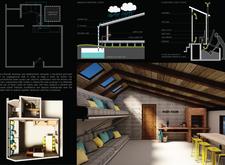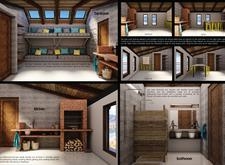5 key facts about this project
## Project Overview
The Hugrekki Cabin is situated in Iceland and designed to serve as a shelter for adventurers in remote environments. This architectural endeavor reflects a commitment to harmony with the natural landscape, integrating adaptability and comfort through a minimalistic approach. The structure is intended for varied uses, including recreation and everyday living, while capturing elements inherent to Icelandic culture.
## Geographical Context and Resilience
The design account for Iceland's rugged terrain and challenging weather patterns. The strategic orientation of the cabin is tailored to withstand extreme winds and variable precipitation. A gabled roof facilitates efficient rainwater management, while the chosen materials enhance both durability and aesthetic appeal within this demanding environment.
## Form, Materiality, and Sustainability
The cabin incorporates a straightforward yet impactful design, employing:
- **Concrete**: For structural support and aesthetic warmth.
- **Wood**: As a finishing element that provides both texture and strength.
- **Recycled Galvanized Steel**: Utilized in washbasin and shower areas, highlighting eco-friendly construction practices.
A slanted roof integrates a rainwater harvesting system and maximizes natural light through strategically placed skylights, reducing energy usage and enhancing the interior environment.
Internally, the layout is modular, featuring a multifunctional main room that supports diverse activities, including dining and socializing. Private areas offer comfort and flexibility, ensuring each aspect of daily life, from resting to cooking, is thoughtfully accommodated within the cabin's compact dimensions.
Sustainability is a core principle, demonstrated by features such as a rainwater harvesting system that collects water for reuse, a composting toilet that minimizes potable water consumption, and large windows that optimize solar access for natural heating and lighting.
This architectural initiative exemplifies the intersection of usability, environmental respect, and cultural reflection, showcasing a unique approach to sustainable design in a remote context.






















































